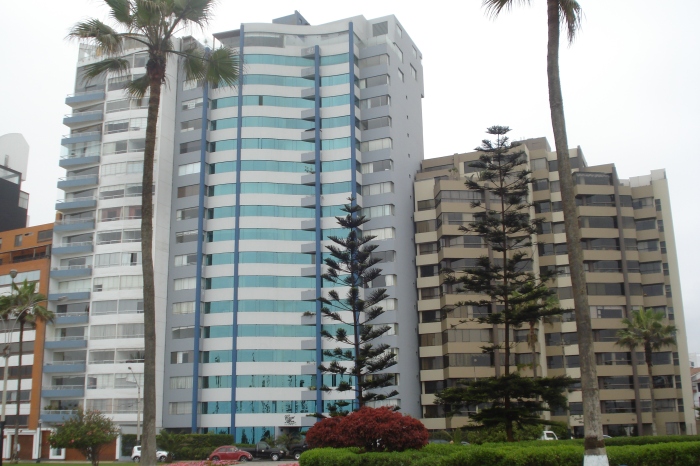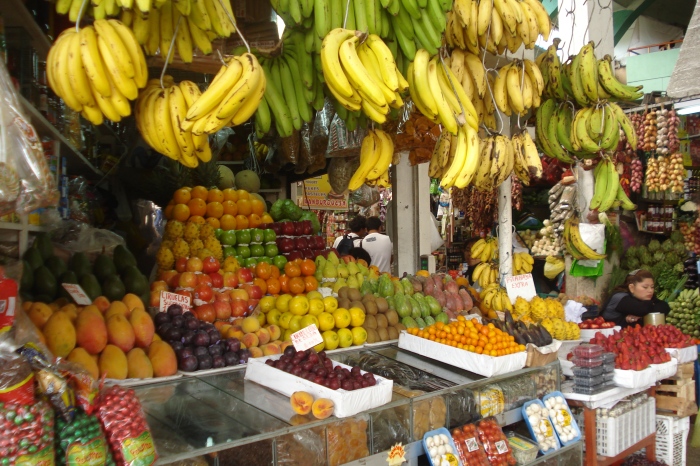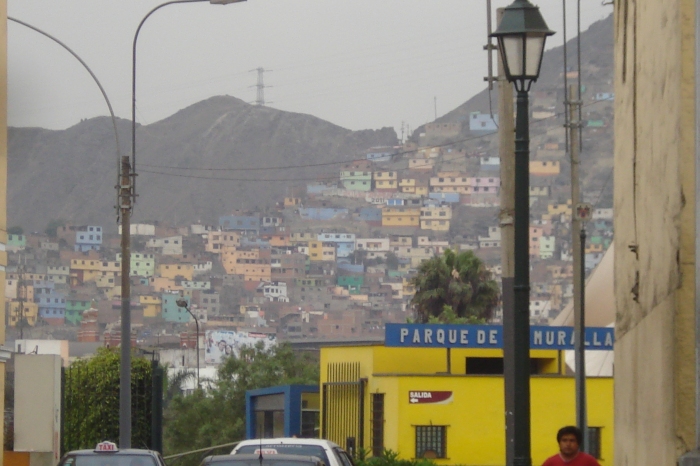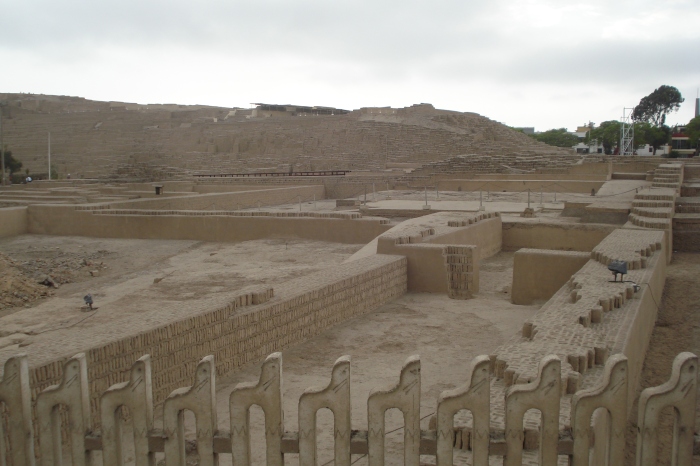As with so much of this exasperating yet alluring continent, the glaring divide between the impoverished and the wealthy is markedly felt in Peru, perhaps nowhere more deeply accentuated than here in the capital of Lima. Impossibly shiny, cloud sweeping skyscrapers rivaling those of downtown Miami, stand firm next to centuries-old churches and crumbling cathedrals. Smartly dressed Limeños and tourists enjoy pisco sours and imported wines on the terraces of some of the world’s finest restaurants, against the backdrop of a sprawling shanty town (pueblo joven) looming in the distance up a mountain.

Behind the security guards and iron railings on their windows, a well-to-do couple sit back in the reclining chairs of their luxury apartment, enjoying the latest Harry Potter movie on a plasma TV screen as the cry of “tamales” from a wizened old lady outside, bent over her wicker basket is muted by the very best in surround sound home cinema. A mayhem of multiple types and sizes of public transports rattle by, the ticket collectors wolf whistling and frantically grabbing at the attention of passersby, yelling out the bus’s destinations and scooping up as many passengers as possible, whisking them into the moving vehicles to a spluttering of exhaust and beeping of horns.
“Dios está conmigo”(God is with me) and “Jesus vive” (Jesus Lives) are just some of the lettering painted onto the sides of their brightly colored vehicles, a constant reminder that the Catholic church reigns strongly in this corner of the world. The Good Lord is worked into as many sentences as possible and travelers will find themselves blessed regularly throughout their day here in their interactions with the Peruvian people.
Lima is a fascinating city breaking so many stereotypes of Peru as a wild and rugged, underdeveloped land suitable only for the most intrepid of travelers, prepared to brave the Inca trail to Machu Picchu, camping gear in tow. A far cry from the mountainous regions, where the locals feed on wild cuy (guinea pig) and clans still live on floating islands in Titicaca made from lake reeds, coastal Lima is in many ways a throbbing modern metropolis.

Construction of high rise apartment blocks is abundant and the swanky neighborhoods of Barranco and Miraflores propel the visitor at any moment to downtown North America, and then the next to a Parisian corner of tucked away restaurants, bars and art galleries. The abundance of museums, theaters and cultural events make up for the looming sea fog that hangs over Lima for the greater part of the year, turning everything damp and cold and enveloping the city with its grayness.
From the Museo Nacional de Antropologia, Arqueologia e Historia, that captivatingly recreates Peru’s rich millennial past in archaeology, history and culture, to the Museo de Arte exhibiting an impressive array, from striking Peruvian prehistoric collections and first human discoveries to bold contemporary pieces, art and history lovers will delight in Lima’s hidden treasures.
Although the best way to appreciate this thrilling, multi-layered city has to be through its cuisine and everyone’s tastes are catered for. With some of the most exciting fusions of flavors taking place in Peru, attracting up-and-coming chefs from all over the world, Peruvians’ understanding of the delicate balance of spices and necessity for a little piquante here and there is unrivaled in many other parts.
Comedores and casual-style restaurants serve up a midday “menu” which includes two or three courses and a glass of chicha morada (black corn pulp) or some other soft drink. For 3 or 4 dollars you can fill up on a plate of ceviche and lomo saltado (pan fried pork and vegetables with rice) or a soup and fried chicken or fish, all cooked in exquisite sauces and, despite the price, still attractively presented on the plate with painstaking attention to detail.

For those calling for a little more refinement, the chic restaurants behind illuminated fountains and frosted glass windows serve up international cuisine with a Peruvian twist, from seared tuna steak, to citrus curries and tasty and abundant portions of salads with a variety of vegetables, brightly colored and with a real, fresh, earthy taste, not purchased and imported out of season, nor wilting and sad-looking with the brown lettuce leaves shoved to the bottom.
Downtown is a historical treat of colonial buildings with some Arabian details in the balconies and roofs, mimicking Granada’s Alambra and demonstrating even more of the cultural diversity and many races and influences that have left their stamp on this city. From the Spanish to the Chinese, English, Americans, German, Arabian and Japanese, all have fused into what makes Peruvians today, each culture bringing with it the best and the worst from their lands.
Trendy young office workers communicate with blackberries and I-phones, fluent in text speak, Twitter and Facebook, mixing Spanish and English and managing to hold a perfect conversation with their companions while sending an email with one hand. Well dressed and well versed on current events in the rest of the world, they are astute and ambitious, educated and hardworking, driving Peru’s digital economy forward.
Away from the buzz and along the malecon, or “sea walk”, lovers take a stroll to the parque del amor (the park of love), where the stunning monument to Rodin’s the kiss sculpture is illuminated at night in a flame of lights and the intricate tiling on the benches, beautifully cut flowers and impeccably clean pathways follow the coastline that falls away into the sea below.
Losing yourself in the backstreets (although not too far from the populated areas) you come across some of the most interesting places of all – spectacular markets bursting full of spices and smells, and varieties of fruits and vegetables that have never made it to European shores. Potions and lotions and medicines for impotence, aphrodisiacs, herbs to clean kidneys, ripped off brands of clothing, electrical goods, carpets and tapestries, Tupperware and cleaning products, just about everything is available under the arches of the Mercado Central.

Not far away from the centre you stumble across an incredible Adobe ruin, Huaca Puclana, an ancient pre Inca site made entirely out of clay. Sadly, it has been split into two by a road, but is still amazingly well preserved despite falling victim to the march of progress in a time before protection legislation was in place. There aren’t many cities in which you can see modern day skyscrapers, 16th century churches and archaeological sites from circa 200 AD in a matter of only minutes.

Just a few days is not nearly long enough to enjoy everything that Lima has to offer, but it certainly gives you a taste that inevitably leaves you wanting more, confirming for me that Peru is about so much more than the Inca trail and the Nasca lines.
Having been in Bolivia and Argentina, I’m going to Peru and Colombia this year, so I’m curious to know how many days you would recommend in Lima.
LikeLike
I think two days, two night would be good. If you only have one, then you can get a lot done in it, but two days will give you a chance to make take a city tour and get a snap shot of everything and then the next day chill out in Miraflores or Barranco. I never went to a beach in Lima. I think you could probably spend even more time there, but there is this damn sea fog half the time that just doesn’t make going to the beach there fun. Yeah. I would say two days, two nights. 🙂
LikeLike
You write so beautifully, it was a pleasure to read.
LikeLike
Thank you very much! That’s very kind of you. Have a great day. 🙂
LikeLike